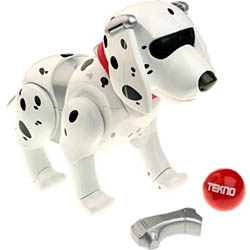Boomer the Tekno Puppy
Boomer is a very realistic and colorful dog that acts just like the real thing.
 Boomer is a very realistic and colorful dog that acts just like the real thing. His movements and reactions replicate the movements of a real dog. He walks in two speeds, wags his tail and shakes his head. Boomer can even be taught how to talk.
Boomer is a very realistic and colorful dog that acts just like the real thing. His movements and reactions replicate the movements of a real dog. He walks in two speeds, wags his tail and shakes his head. Boomer can even be taught how to talk.
Children's fascination with robot dogs can be attributed to a combination of factors that appeal to their imagination, curiosity, and emotional connection. Robot dogs offer a unique blend of technological innovation and companionship, making them appealing playmates for young audiences. Here are several reasons why children are drawn to robot dogs:
- Novelty and Technology: Robot dogs represent cutting-edge technology, which naturally intrigues children. The idea of having a pet that is also a robot combines the familiarity of a pet with the excitement of exploring futuristic innovations.
- Mimicking Real Dogs: Many robot dogs are designed to mimic the appearance and behaviors of real dogs. This resemblance creates a sense of familiarity and comfort, allowing children to interact with a pet-like companion even if they don't have a real dog.
- Interactive Play: Robot dogs are often designed for interactive play. Children can control their movements, commands, and responses, providing an engaging and dynamic play experience that fosters creativity and imagination.
- Companionship: Robot dogs offer companionship to children. They can be a source of comfort, especially for those who may not have access to a real pet or who are looking for a playmate that can respond to their interactions.
- Responsibility and Care: Caring for a robot dog by "feeding," "walking," and interacting with it simulates the responsibilities associated with having a real pet. This experience allows children to practice empathy, nurturing, and a sense of responsibility.
- Emotional Bonding: Children often form emotional connections with their robot dogs. The robot's ability to respond to touch, commands, and affectionate gestures can elicit feelings of attachment and bonding.
- Safe Exploration: Robot dogs provide a safe way for children to explore the concept of having a pet and learn about animal behavior without the potential risks associated with real pets, such as allergies or potential aggression.
- Adaptable Play: Robot dogs can adapt to different play scenarios and preferences. Whether children want to engage in active play, teach their robot dog tricks, or simply cuddle with it, these toys offer versatile entertainment.
- Entertainment and Learning: Many robot dogs are designed to provide educational content and activities. They can help children learn about programming, technology, and problem-solving in a playful and enjoyable way.
Children are drawn to robot dogs because they combine technological innovation with the appeal of companionship, interactive play, and emotional bonding. Robot dogs offer a safe and engaging way for children to experience the joys of pet ownership, nurturing relationships, and exploring the world of technology.
